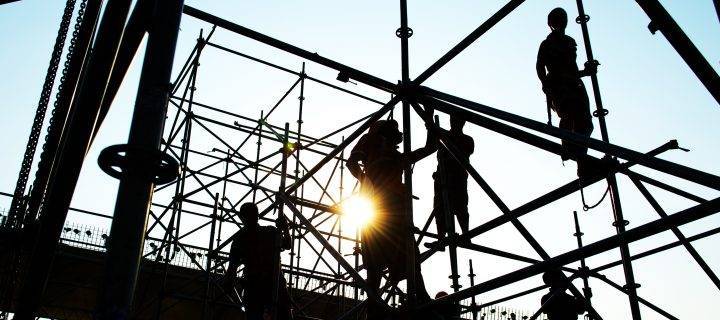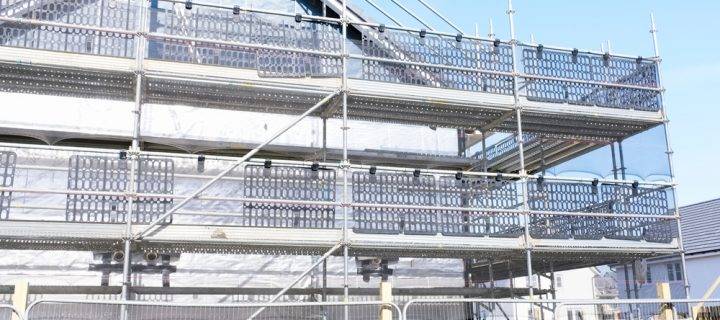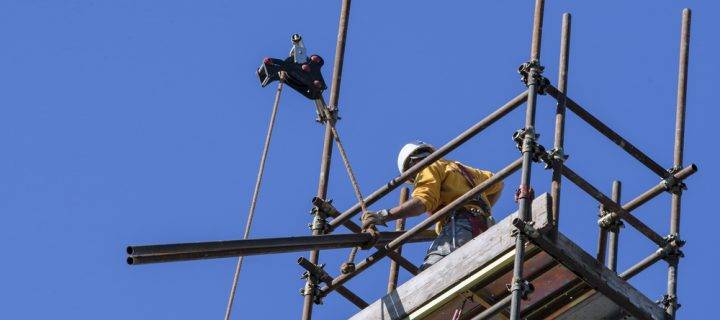The importance of a preliminary tie test for any scaffolding used in construction works cannot be understated. This task should be carried out away from the area where the scaffold is erected which prevents stressing on the facade where it is being positioned. A preliminary test load has different rules, based on the type of Tie which makes it crucial to know the type of Tie being used to ensure an accurate design is provided. Five tests need to be carried out in each different base material of the project which are carried out on sample anchors in the same base material. This again should take place away from areas which are being used and must not be used in the job at any time. The tests include pulling without slipping for a working load of two non-nylon tie, then take further consideration for three times using a nylon-based tie. If all of these tests pull without slipping for a working load of 2 non-nylon tie then it is okay and no further consideration needs to be taken. If the ties move or slip during this stage then the tie would fail. Non-nylon ties will need either the average failure load divided by three for the maximum permissible tie load or the worst-case failure on the weakest test which is then divided by 2. The Right Time to Test Scaffold Ties Using our decades of experience, Network Scaffold understand these tests will take place between the design phase and the start of construction. The tie load information for the tests to take place, needs to be clearly stated to the scaffolding contractor for the preliminary testing. Proof testing is sometimes confused with the overall tie test load for scaffolding but these are two different practices. This testing is only quality checking when the scaffold is in place. Proof testing needs to be carried out with a minimum of three ties or 5% of all ties; whichever is greater. Contact the Scaffolding Specialists If you have any questions about scaffolding ties, please get in touch with Network Scaffold today. We are the leading supplier of scaffolding and access scaffolding in Derbyshire and the surrounding...
Read Moreabout Your Guide to Testing Scaffolding TiesAcross the scaffolding industry, the number of accidents and injuries fell to an all-time low in 2019. This is according to the NASC, with just 74 incidents reported throughout the calendar year. Explaining the NASC Safety Report These figures were released in the NASC 2020 Safety Report, a document which analyses accident and injury stats for all members, which encompasses 17,000 scaffolding operatives in the UK. Another fantastic statistic revealed that 99% of NASC member-employed operatives went through the whole of 2019 injury-free. For the seventh year in a row, there was also no operative fatalities. The 74 incidents equate to one injury for every 230 operatives, a significant improvement on last year’s one injury for every 150 operatives. From the total incidents, 13 were recorded as major (meaning they required hospital treatment) with the rest recorded as over 7-days. Both of these figures were also the lowest on record. Slips, trips and falls accounted for the majority of reported incidents – 28 in total. This is now the 15th year in a row that slips, trips and falls have been the main cause of injury to operatives. This accounts for 21% of injuries in 2019. Lynn Way, NASC President commented, “The 2020 Safety Report demonstrates in no uncertain terms that NASC members are incredibly safe, and justifies the decision taken by an increasing number of main contractors to specify NASC-only for their scaffolding requirements.” The Safest Scaffolding in Derby Our first priority here at Network Scaffold is the safety of both our staff, on-site workers and members of the public – dependant on the type of job. This is why our Health and Safety Policy is so robust, encompassing – Compliance with the latest laws and regulations Effective communication relating to safety on-site Collaboration with customers and suppliers to ensure jobs are delivered safely Constant re-assessment of our procedures to adapt to new site practices We also support any worker who refuses to work on a site due to poor health and safety Network Scaffold is the leading provider of scaffolding in Derby; if you would like to know more about our services please contact us...
Read Moreabout Safe Scaffolding Means Less AccidentsNew guidance has been released to scaffolders with changes to working practices due to the Coronavirus pandemic. Information from the Department for Business, Energy and Industrial Strategy covers all those working outdoors and managing outdoor working environments (such as scaffolding). The intention is to give workers enough freedom within a practical framework to complete their work during the pandemic. Network Scaffold has been extremely strict with our working practices since the Coronavirus swept across the country. We will always look to complete our work in the safest environment for all involved; whilst adhering to social distancing techniques. Coronavirus Testing Available for Construction Workers The UK government has revealed that millions of more people are now eligible for Coronavirus tests, including construction workers. At this stage, tests are only intended for those showing symptoms of the virus. An expansion in testing has been made possible because of the introduction of home-testing kits. Mobile units are also been employed; staffed by the armed forces. Construction workers are able to book a test on the government’s test-booking website. 10 New Steps for Safety On-Site Here are ten simple steps that have been introduced to help keep construction workers safe and able to do their jobs. Regular updates on actions being taken to reduce risks of exposure in the workplace Make sure all contact numbers and emergency contact details are fully up to date Ensure managers can spot symptoms of coronavirus and know the actions they need to take Operatives are wearing gloves when handling materials and equipment Wash stations are provided with hot water and soap Encourage all staff to wash their hands regularly Schedule break times to reduce the number of people together in canteens at one time Avoid using shared pens when signing in and out of sites Wash or sanitise hands after the use of biometric sign-in. Provide hand sanitiser and tissues for workers Order Your Scaffolding from Network Scaffold Today We understand that working practices are changing in these unprecedented times but if require scaffolding for your project please contact us today. Network Scaffold provides scaffolding for customers across Derby, Nottingham and...
Read Moreabout How Scaffolding Is Changing Due to COVID-19Scaffolding inspections are an integral part of ensuring the work being conducted is safe and adheres to industry standards. Here at Network Scaffold, we understand the importance of ensuring the safety of our team, other workers and the general public (depending on the location of the site). For our latest blog, we are going to talk about workers who can undertake scaffold inspections. The Importance of Qualified Scaffolding Inspectors Legislation states that anyone carrying out inspections must be competent, meaning the person must have the necessary training, knowledge and experience. As a minimum, they should have one of the following qualifications – 1. A Construction Industry Scaffolders Record Scheme (CISRS) cardholder, provided their employer demonstrates necessary knowledge and experience. 2. A CISRS Advanced Scaffolder cardholder, again provided their employer demonstrates sufficient knowledge and experience. 3. A CISRS Scaffolding Supervisor cardholder, plus if the person also holds the Advanced Scaffolders card they are deemed competent to inspect advanced structures. 4. A person who has taken the Basic Scaffold Inspection Course, and can demonstrate the necessary knowledge and experience from the course. 5. A person who has taken the Advanced Scaffold Inspection Course, and again shows sufficient knowledge and experience gained from the course. 6. Persons required to carry out inspections of System Scaffolds must have their card endorsed with the product selected plus attending the basic scaffold inspection course and attend an approved product training course for the specific system scaffold required. Speak to the Scaffold Specialists Today If you require scaffolding for your next project, look no further than Network Scaffold; the leading provider in Derby and the surrounding areas. Network Scaffold can also provide alloy towers, edge protection and access scaffolding for both domestic and commercial projects. If you have any more questions about scaffolding, please contact us or visit our FAQ page to see if answers are already provided on this...
Read Moreabout Who is Competent for Scaffold Inspections?In the wake of the COVOD-19 pandemic, new guidelines have been released from the Scaffolding Association regarding risk assessments and site inspections. As an associated member of the Scaffolding Association, Network Scaffold are adhering to new measures put in place to maintain social distancing and keep our workforce and the general public safe. The Importance of Risk Assessments A risk assessment is a key element to determining the frequency of periodic inspections and identifying scaffolds that may be at most risk from adverse weather. Here are some points that should be considered for risk assessments on low risk and high-risk sites – Low-Risk Sites This type of site is usually self-contained with a low risk of the scaffold structure being compromised or components falling outside of the site boundary. Examples include – Site using scaffold that is less than 10 metres in height Sites with fencing or hoarding where the scaffold is not adjacent to the boundary A commercial site where the business operations have ceased High-Risk Sites This type of site will be situated in the public domain, or are self-contained with the scaffold structure at high risk of being compromised or components falling outside of the site boundary. Here are four examples to note – Sites with scaffold over 10 metres in height A site using sheeted scaffolds or temporary roofs Sites adjacent to highways, transport areas or utilities A commercial site where the business operations continue to function How to Undertake Scaffolding Inspections The Government is currently advising that people, except for essential workers, to stay at home because of the direct risk to life from COVOD-19. Where undertaking an inspection is necessary, guidelines should be considered and implemented. Before attending site for inspections, you will need to have the following in place – The correct contact details of the Client or Principal Contractor Arrangements for gaining safe access to the site Suitable lone working procedures for the Scaffold Inspector COVOD-19 risk assessment for the Scaffold Inspector COVOD-19 risk assessment for any individuals required to carry out necessary remedial works Want to Know More? Contact Us Today If you have any more questions about scaffolding services provided by Network Scaffold, please get in touch...
Read Moreabout Guidance for Scaffold Inspections and Risk AssessmentsAlloy towers hold many advantages over ladders for jobs that need completing around homes or in the garden. Network Scaffold is the leading supplier of scaffolding and scaffold towers across Derbyshire, which is why we have put together five reasons you should be choosing them every time. Five Reasons to Use Scaffold Towers 1. Safety – Scaffolding towers are much safer than ladders, as they have a wider surface area plus they are supported on four legs making them free-standing. Ladders, on the other hand, are on two legs and rest at an angle. Ensuring you have a flat platform to work on is much more stable and do not have to worry about falling off a ladder that could wobble and requires closer supervision and care when in use. Safety is the top priority for scaffold towers and is made clear from erecting the scaffold to dismantling it. 2. The Platform – The platform on alloy towers allows you to move around more freely and have your tools and equipment close by, plus you can leave it in place for longer. Eliminating the hassle of moving ladders, using a tower will prove a great time saver. The structures platform reduces the need for accompanying assistance, whereas with a ladder you will need someone at the base to make sure it is secure. Platforms are also equipped with bars or guide rails to prevent users from falling off, which enhances its safety. 3. Easy to Work On – Alloy towers make jobs such as painting and de-guttering quite straightforward, helping you gain access to difficult to reach areas. The ability to work more easily means that work will be completed faster. Ladders are useful for smaller tasks, but if you need a more robust and professional piece of equipment then scaffold towers are the best choice. 4. Straightforward to Manoeuvre – Scaffold towers are usually equipped with wheels, which allows users to change the location of the tower easily, compared to cumbersome ladders. Whilst moving a tower you should always reduce the height to no higher than 4 metres. Before moving the tower ensure the ground is stable and there are no risks to the tower or the user...
Read Moreabout Choosing Scaffold Towers Instead of a Ladder





